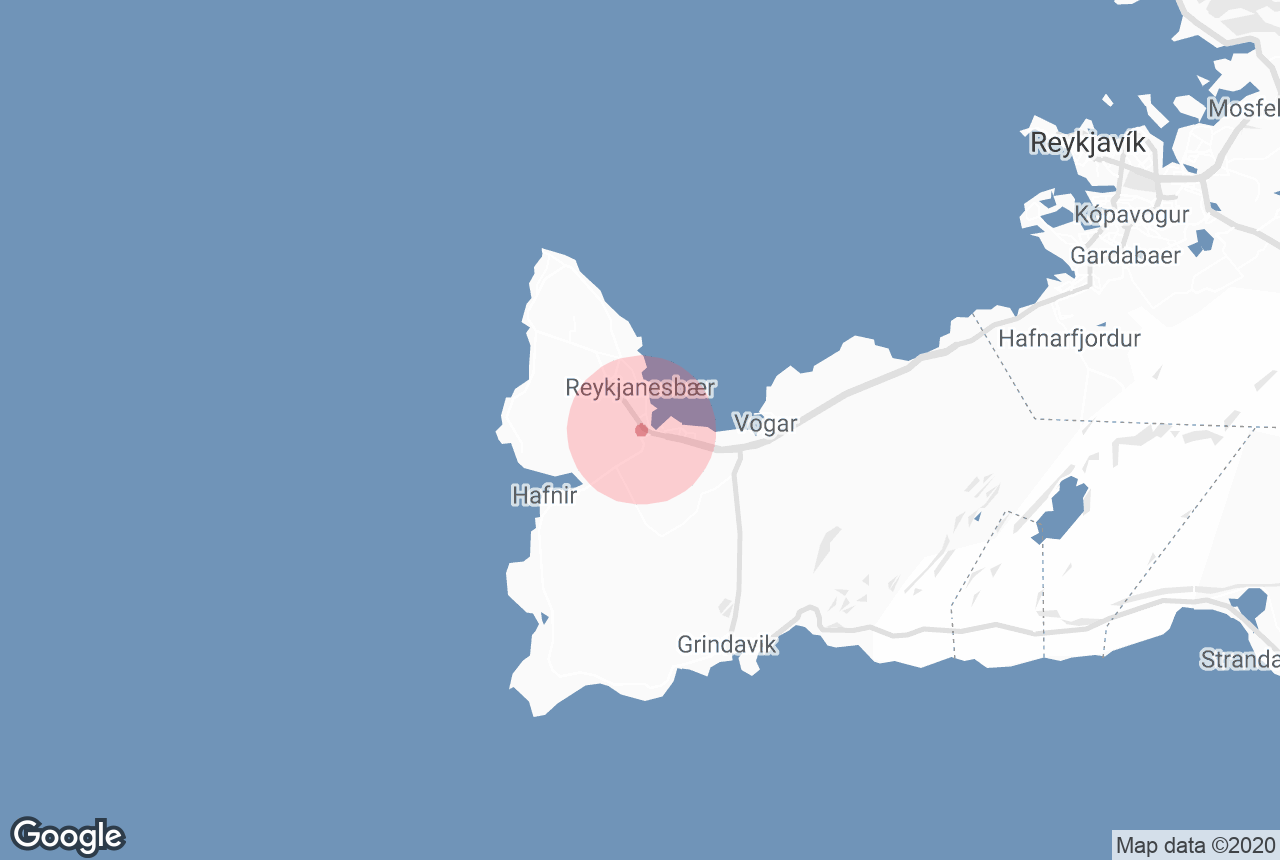
This geological landmark lies on the Reykjanes Peninsula, about 31 miles (50 kilometers) from Reykjavik and 14 miles (23 kilometers) from Keflavik International Airport. Its proximity to both makes it an ideal stop for travelers exploring the surrounding area.
The site is commonly included in Reykjanes tours, often combined with visits to geothermal fields, coastal cliffs, and lighthouses. For those who prefer more flexibility, it’s also easily accessible with car rentals, offering a convenient detour on a personalized route.
Why You Can Trust Our Content
Guide to Iceland is the most trusted travel platform in Iceland, helping millions of visitors each year. All our content is written and reviewed by local experts who are deeply familiar with Iceland. You can count on us for accurate, up-to-date, and trustworthy travel advice.
Because of its location and ease of access, the bridge fits naturally into many self-drive tours, especially those focused on Southwest Iceland. It also makes a logical starting or ending point for a self-drive tour of the complete Ring Road, due to its closeness to the airport.
Key Takeaways
-
This astonishing Icelandic attraction signifies the meeting of two tectonic plates and allows visitors to see the resulting volcanic landscapes.
-
Visiting the bridge is easy if you’re staying in Reykjavik and want to explore the Reykjanes Peninsula.
-
There are plenty of other natural attractions and sightseeing opportunities close to the bridge.
-
Guided tours take visitors throughout the Reykjanes Peninsula, many stopping at the bridge.
The Geology of the Bridge Between Continents
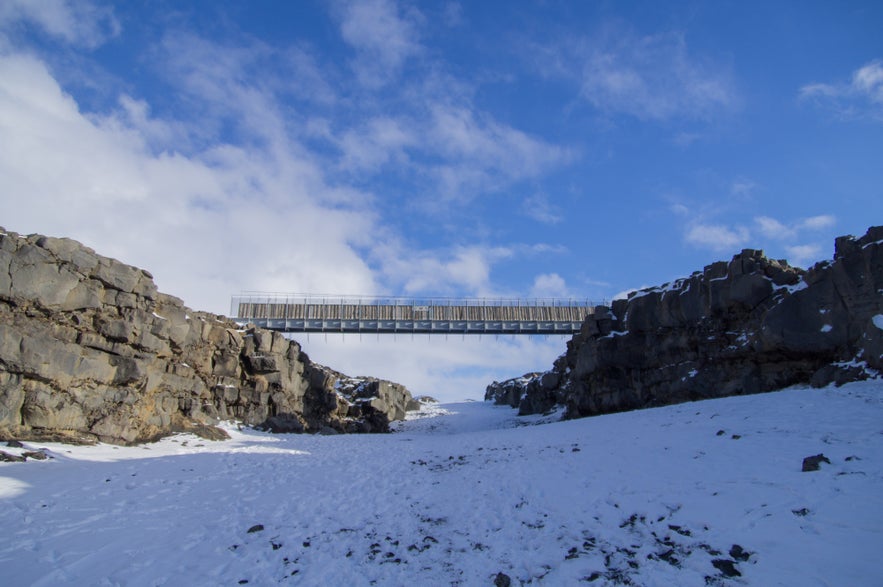 The Mid-Atlantic Ridge is a vast underwater mountain range that stretches from Northern Greenland to Antarctica. It marks a divergent plate boundary, where the North American and Eurasian tectonic plates slowly move apart, separating at a rate of about 1 inch (2.5 centimeters) per year.
The Mid-Atlantic Ridge is a vast underwater mountain range that stretches from Northern Greenland to Antarctica. It marks a divergent plate boundary, where the North American and Eurasian tectonic plates slowly move apart, separating at a rate of about 1 inch (2.5 centimeters) per year.
While most of the ridge lies deep beneath the Atlantic Ocean, Iceland is one of the few places where it rises above sea level. As the plates drift apart, magma rises to fill the gap, creating frequent volcanic activity and earthquakes that continually reshape Iceland’s landscape.
This tectonic rift runs along the Reykjanes Peninsula, through Iceland’s Highlands, and out across North Iceland near geological hotspots like Askja and Krafla Calderas close to Lake Myvatn.
As a result, West Iceland, parts of North Iceland, and the Highlands lie on the North American Plate, while the rest of the country rests on the Eurasian Plate.
At the Bridge Between the Continents, located on the Reykjanes Peninsula, visitors can see and walk across the rift valley between the plates. It isn't a literal path between the two. Think of it as a symbol of the meeting of two significant land masses.
Visiting The Bridge Between the Continents
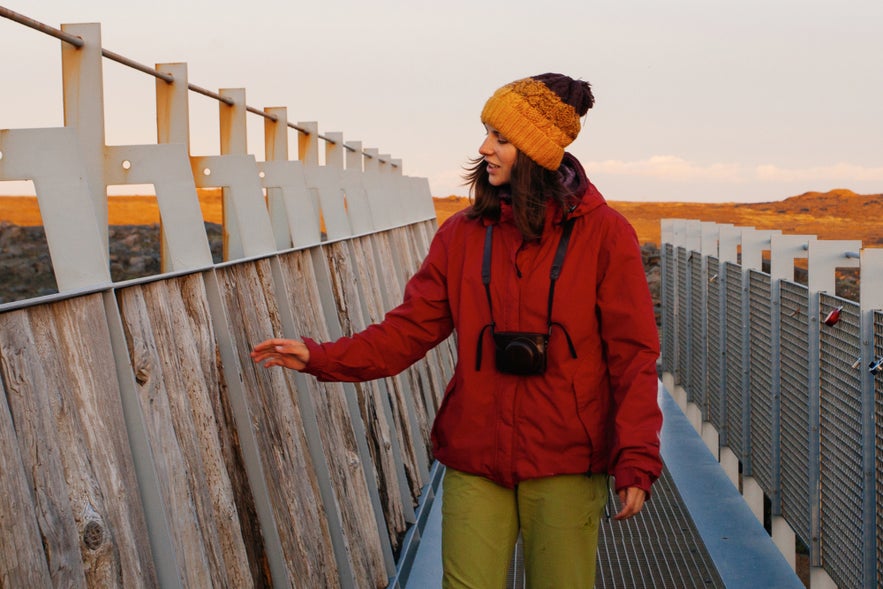 The best place to see the tectonic plates in Iceland is in Thingvellir National Park, a UNESCO World Heritage Site on the Golden Circle Route.
The best place to see the tectonic plates in Iceland is in Thingvellir National Park, a UNESCO World Heritage Site on the Golden Circle Route.
However, the bridge is also a convenient location if you are staying in Reykjavik. It’s also not far from the Keflavik International Airport, making it an ideal first stop after arriving on the Reykjanes Peninsula.
Renting affordable cars or booking self-drive tours are among the most budget-friendly ways to explore the region at your own pace. You’ll go south on Route 40 out of Reykjavik, following the road onto Route 41 before turning onto Route 44. This road eventually leads to Route 425, where the bridge is situated.
Tours Around Iceland's Bridge Between Continents
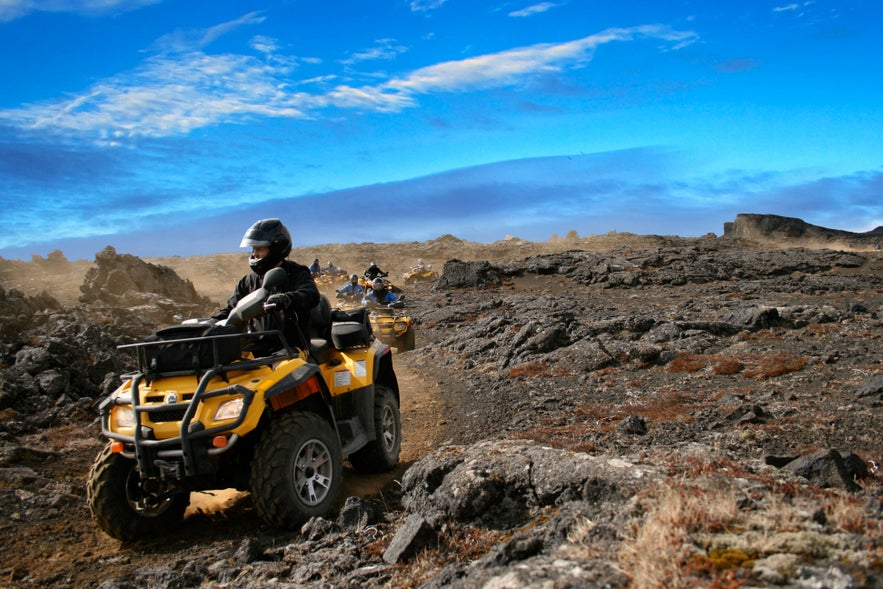
Here are several tours to consider if you’d like to see the Bridge Between the Continents:
-
Volcano Hike & Sightseeing Tour — Hike to the recent lava fields on the Reykjanes Peninsula, visit dramatic geothermal and cultural landmarks, and walk across the Bridge Between the Continents.
-
Reykjanes Peninsula & Blue Lagoon Tour — Explore the geothermal wonders, crater lakes, and rugged coastlines of the Reykjanes Peninsula, including a visit to the Bridge Between the Continents.
-
3-4 Hour ATV Tour of the Reykjanes Lava Fields — Depart from Grindavik and take an exciting ride through lava fields, to the top of Helgafell Mountain, and to the Bridge Between the Continents.
Or, if you’d like to take Iceland at your own pace, check out these self-drive tours where you can add a stop to the Bridge Between the Continents:
-
7-Day Northern Lights Self-Drive Tour — Set out through the South Coast, Golden Circle, Snaefellsnes Peninsula, and Reykjanes Peninsula, visiting iconic natural wonders, exploring ice caves, and chasing the northern lights.
-
10-Day Self-Drive Tour of the Ring Road & Snaefellsnes Peninsula — Embark on this self-drive tour around Iceland, exploring top attractions and hidden gems, including the Reykjanes Peninsula.
-
5-Day Northern Lights Winter Self-Drive Tour — Discover the best of Iceland in winter with optional stops at the Bridge Between the Continents and the chance to chase the northern lights each night.
Attractions Near the Bridge Between the Continents
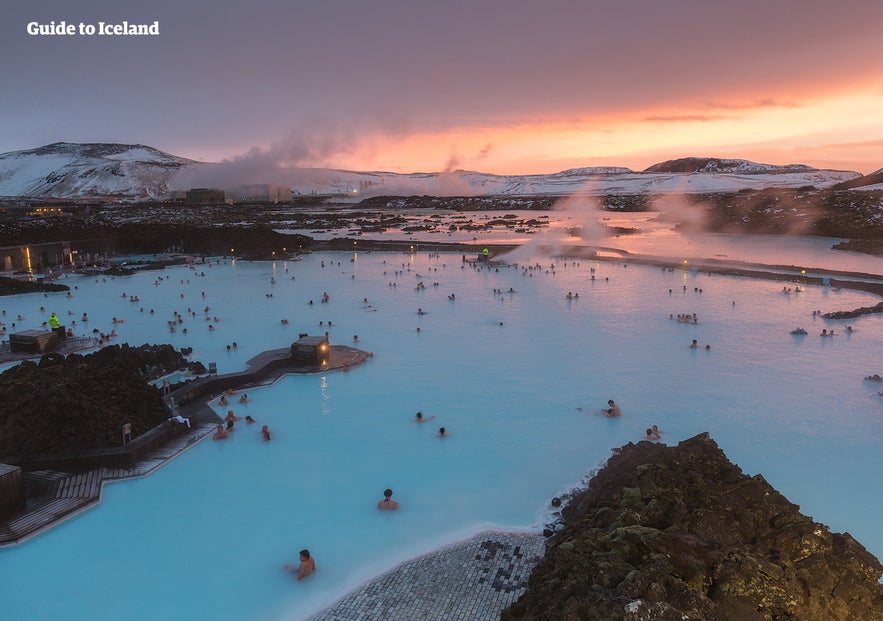 If a visit to the bridge is on your itinerary, you might as well check out other nearby attractions on the Reykjanes Peninsula. Here are some top destinations that showcase Iceland’s unique and powerful geography:
If a visit to the bridge is on your itinerary, you might as well check out other nearby attractions on the Reykjanes Peninsula. Here are some top destinations that showcase Iceland’s unique and powerful geography:
-
Hafnaberg Sea Cliffs — Witness the raw power of the North Atlantic against these unusual rock formations. The cliffs are about 3 miles (4.5 kilometers) from the bridge.
-
Gunnuhver Geothermal Area — This haunting and majestic geothermal field features boiling mud pools and steam vents. It’s about 4.3 miles (7 kilometers) from the bridge.
-
Blue Lagoon — One of Iceland’s most popular attractions, this geothermal spa features vibrant, mineral-rich waters. It’s about 15 miles (24 kilometers) from the bridge.
-
Krysuvik Geothermal Area — Mineral deposits color a landscape full of mud pools, hot springs, and steam vents. It’s about 30 miles (49 kilometers) from the bridge.
-
Kleifarvatn Lake — This stunning lake is known for its geothermal activity, hot springs, and lava-covered landscape. It’s about 33 miles (53 kilometers) from the bridge.
There are also several villages on the Reykjanes Peninsula that offer a glimpse into Icelandic culture. Think about visiting Sandgerdi and Gardur while exploring the region.
And if you’d prefer to explore the Reykjanes Peninsula with all the details handled for you, these top-rated tours are a great choice:
-
Guided Hiking Tour of Reykjanes Peninsula Volcano Area — Choose between an afternoon or evening tour that sets out from Reykjavik to see some of the most amazing volcanic landscapes on the Reykjanes Peninsula.
-
Blue Lagoon Tours — Choose your ideal trip to the Blue Lagoon geothermal spa and experience why it’s one of Iceland’s most popular attractions.
-
Helicopter Tour of the Reykjanes Volcanic Fields — Get a bird’s eye view of the volcanic landscapes that make Reykjanes Peninsula so unique and check out Reykjavik from above on your way back.
FAQs About the Bridge Between the Continents
Below are answers to some of the most frequently asked questions to help you plan your visit and understand the unique significance of this geological site.
Is there an entrance fee for crossing the bridge?
No, visiting the area and crossing the bridge is free. You can get a personalized certificate at the Reykjanes Information Center that marks your crossing of the famous bridge.
How long does it take to visit the bridge?
Most visitors spend 15 to 30 minutes exploring the bridge and the surrounding rift valley. You can cross the bridge very quickly, but it’s worth staying for a while and taking in the geography.
Is the Bridge Between Continents a fault line in Iceland?
No. While the Mid-Atlantic Ridge is a major fault line that runs through the area, the bridge is actually over a rift. This is an area where the two tectonic plates slowly pull away from each other.
What should I bring when visiting?
Wear warm clothing and bring layers, even in summer, as the area is often windy. In winter, expect very cold conditions and stronger winds. It’s important to wear supportive hiking shoes when exploring the rocky area. If you don't want to bring shoes with you, you can rent hiking shoes to save on luggage space. Don’t forget your camera.
Is the site wheelchair accessible?
The bridge itself is accessible with a paved path leading from the parking lot directly to the bridge. However, the surrounding terrain is rough and challenging for wheelchairs or strollers, which can limit access for visitors with mobility issues and families with small children.
Is there on-site parking?
Yes. There’s a small parking area for visitors. It’s a short walk from the parking area to the bridge.
Are there facilities like restrooms or cafes nearby?
Unfortunately, there are no restrooms or food options at the bridge itself. Make sure you bring a snack if you plan on staying for a while. The nearest facilities are near the Blue Lagoon.
What’s the best time of the year to visit?
The bridge is accessible year-round, but the best times to visit are during spring, summer, and early autumn for good weather and clear walking paths. Winter weather is often harsh, but if you're visiting during this season, you'll have a better chance of seeing the northern lights.
Does the bridge have a nickname?
Some people refer to the bridge as the “Continental Bridge” due to the meeting of the two major tectonic plates. It’s also called “Leif the Lucky Bridge” after the Icelandic explorer Leif Erikson.
When was the bridge built?
The Icelandic Road and Coastal Administration built the bridge in 2002 to highlight the geographic significance of the area. It was also intended to promote geological tourism in the Reykjanes Peninsula.
Stand on the Bridge Between Continents
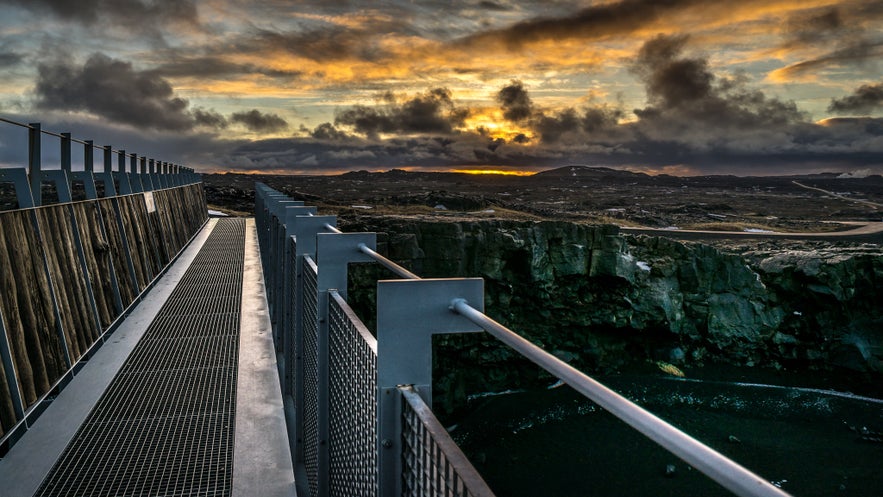 Photo from Wikimedia, Creative Commons, by Giuseppe Milo. No edits were made.
Photo from Wikimedia, Creative Commons, by Giuseppe Milo. No edits were made.
Add a visit to the Bridge Between the Continents to your Iceland trip itinerary and experience a geological occurrence few get to see. Crossing the bridge is exciting, but the surrounding area shows the power and beauty that results when two tectonic plates meet.
